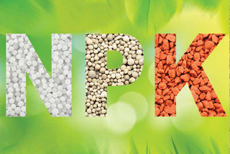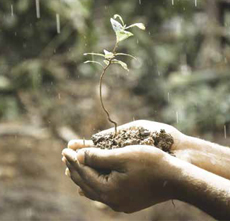Understanding Your Plant Analysis Report
 Total Nitrogen: Nitrogen is a critical part of proteins in the plant. It is also an important part of chlorophyll and plays a key role in photosynthesis. Nitrogen deficient plants usually have a pale green or yellow colour. In grasses, the yellowing usually starts at the leaf tip and goes down the middle of the leaf. Because nitrogen is mobile in the plant, the older leaves will show the symptoms first.
Total Nitrogen: Nitrogen is a critical part of proteins in the plant. It is also an important part of chlorophyll and plays a key role in photosynthesis. Nitrogen deficient plants usually have a pale green or yellow colour. In grasses, the yellowing usually starts at the leaf tip and goes down the middle of the leaf. Because nitrogen is mobile in the plant, the older leaves will show the symptoms first.
The total N content of a plant includes all forms of nitrogen in the plant tissue. The total N content represents the nitrogen status of a crop up to that point in the growing season, but does not predict the nitrogen status of the crop in the future.
Phosphorus: Phosphorus is important for root growth, seed production and crop maturity along with many other functions. Symptoms of plants deficient in phosphorus include stunted growth, delayed maturity and seed production. In young plants, phosphorus deficiency may appear as purple colouring of the older leaves. Phosphorus is mobile in the plant, so deficiency symptoms appear first on the older leaves. The total phosphorus content of a plant includes all forms of phosphorus in the plant tissue.
Potassium: Potassium is involved in many physiological processes including protein synthesis and maintaining the water balance in the plant. Potassium deficiency symptoms include reduced growth and yellowing or burning of the leaf edges. Other symptoms include reduced straw or stalk strength, reduced disease resistance and reduced winter hardiness of perennial crops. Since potassium is mobile in the plant, the symptoms appear on the older leaves first. Sandy soils are more likely to be deficient in potassium.
 Sulphur: Sulfur is a component of plant proteins. Symptoms of sulfur deficiency can look similar to a mild nitrogen deficiency. The only difference is a sulfur deficiency appears sooner on the newer growth because sulfur is not very mobile in the plant. Sulfur deficiencies are more common on sandy soils with low organic matter. In high rainfall years, sulfur deficiencies can occur on most soil types due to leaching of sulfur. Sulfur deficiency is more common in crops such as canola and alfalfa due to higher sulfur requirements.
Sulphur: Sulfur is a component of plant proteins. Symptoms of sulfur deficiency can look similar to a mild nitrogen deficiency. The only difference is a sulfur deficiency appears sooner on the newer growth because sulfur is not very mobile in the plant. Sulfur deficiencies are more common on sandy soils with low organic matter. In high rainfall years, sulfur deficiencies can occur on most soil types due to leaching of sulfur. Sulfur deficiency is more common in crops such as canola and alfalfa due to higher sulfur requirements.
Calcium: Calcium is an important part of cell walls. When a soil is limed to an acceptable pH (6.0), calcium is usually adequate. Agricultural lime is composed of calcium and magnesium carbonates (CaCO3 & MgCO3). The Ag lime applied has enough calcium supplied by the calcium carbonate (CaCO3) for good plant growth. Areas where calcium deficiencies may occur are sandy irrigated soils with a low soil pH (<6.0). Symptoms of calcium deficiency include black scorched leaf tips and die-back of growing points because calcium is not mobile in the plant. Boron can cause the same symptoms, but calcium deficiency does not promote lateral shoot development like boron deficiency does.
Magnesium: Magnesium is a key component of chlorophyll and is essential for photosynthesis. Magnesium deficiencies are rare in the Midwest. When a soil is limed to be acceptable pH (>6.0) magnesium is usually adequate. Agricultural lime is composed of calcium and magnesium carbonates (CaCO3 & MgCO3). When magnesium deficiencies occur, they are usually associated with irrigated sandy soils with a low soil pH (<6.0). Symptoms of magnesium deficiency include mottling of older leaves which proceeds to the younger leaves. The interveinal chlorosis starts in the middle of the leaf, with the margins becoming chlorotic last. In some crops the chlorotic areas of the leaf die and the leaf margins become scorched.
Sodium: High levels of sodium are toxic to plant growth. Healthy plant tissue generally contains very little sodium. Symptoms of sodium toxicity include severe stunting and stand loss. A high level of sodium in plant tissue is caused by excessive sodium levels in the soil and is normally linked to high sodium water.
Zinc: Zinc is essential in the production of many plant enzymes. It is also important in balancing hormone levels in the plant. Zinc is moderately mobile in the plant. In some plants the interveinal mottling appears first on the older leaves and in others it appears on the new leaves first. The interveinal chlorosis may be the same as iron and manganese except that zinc deficient plants usually develop exceptionally small leaves. Zinc deficiencies are common on sandy low organic matter soils. Crops which are sensitive to zinc include edible beans, maize and potatoes.
 Iron: Iron is a component of many enzymes in the plant and is essential for photosynthesis. Iron deficiency starts with interveinal chlorosis of the newer leaves and in severe cases all leaves show symptoms. Soybeans are susceptible to iron chlorosis with some varieties being more sensitive than others. Iron deficiencies are common on soils that have high pH (>7.5), or high soluble salts and high carbonate content (>1.0%). Plant analysis can sometime give very high iron readings (contamination) as a result of the dust that normally occurs on plant tissue contains enough iron to contaminate plant samples. Visual symptoms are used to confirm iron deficiency
Iron: Iron is a component of many enzymes in the plant and is essential for photosynthesis. Iron deficiency starts with interveinal chlorosis of the newer leaves and in severe cases all leaves show symptoms. Soybeans are susceptible to iron chlorosis with some varieties being more sensitive than others. Iron deficiencies are common on soils that have high pH (>7.5), or high soluble salts and high carbonate content (>1.0%). Plant analysis can sometime give very high iron readings (contamination) as a result of the dust that normally occurs on plant tissue contains enough iron to contaminate plant samples. Visual symptoms are used to confirm iron deficiency
Manganese: Manganese is essential for many reactions in the plant and is essential for chloroplast production. Manganese deficiency symptoms include interveinal chlorosis on the newer leaves. These symptoms are difficult to distinguish from symptoms of iron deficiency.
Copper: Copper is essential in forming enzymes involved in photosynthesis. In wheat, copper deficiency symptoms include a twisting or whitening of the leaf tip. In later stages of growth, a browning of the upper stem and head may occur. Copper deficiencies are common on peat soils (>15% organic matter). Mineral soils which are course textured and low in organic matter (<3.0%) may also have copper deficiencies. A history of manure application increases the chance of copper deficiency. Crops most sensitive to copper deficiency include spring wheat, barley and winter wheat.
Boron: Boron is important in cell division and is essential for the production of amino acids. Boron deficiency symptoms include browning or blackening of new leaf tips and die-back of growing points similar to calcium deficiency. Growth of lateral shoots can occur on boron deficient plants. Soils likely to be boron deficient are sandy and low in organic matter (<3.0%). Crops most sensitive to boron deficiency include alfalfa and clover.
Chloride: Chloride is involved in balancing ion charges within the plant, regulating turgor pressure and reducing susceptibility to some diseases. Chloride is also involved in photosynthesis. A minor chloride deficiency will show few if any symptoms. When chloride deficiency becomes severe, small necrotic areas will appear on the upper leaves of crops such as wheat. Crops most sensitive to chloride include spring wheat, barley and winter wheat.
Aluminium: High levels of aluminium are toxic to plant growth. Plants which experience aluminium toxicity will have limited root growth reducing uptake of phosphorus and several other nutrients. Applying lime to bring soil pH to 6.0 or higher will eliminate aluminium toxicity. Aluminium is only tested by special request on plant tissue.